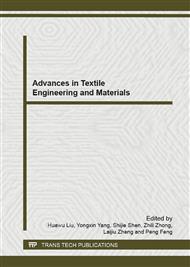p.827
p.831
p.835
p.839
p.844
p.849
p.855
p.859
p.864
Property Evaluation of Polylactic Acid Multilayer Braids Used as Bone Scaffolds
Abstract:
Polylactic acid (PLA), which is biodegradable, is largely used as biomaterial such as bone scaffolds. This study twists PLA filaments into PLA plied yarn, during which twist per inch (TPI) varies as 9, 10, 11, 12, and 13. Tensile strength and elongation of the resulting plied yarn are then evaluated. The optimal TPI is 10, which results from an optimal tensile strength of 3.3 g/den and elongation of 42 %. The optimal plied yarn is made into PLA braids on a 16-spindle braiding machine, with a ratio of take-up gear to braid gear of 60:60, 70:60, 80:60, 90:60, or 100:60. The braids with various gear ratios are then made into multilayer braids with a diameter of 4 mm. The resulting multilayer braids are evaluated for surface observation, porosity and water contact angle. The optimal porosity is 55-65% and the optimal water contact angle is below 30°. This optimal condition indicates that the multilayer braid exhibit good hydrophilicity and a good candidate for bone tissue scaffolds.
Info:
Periodical:
Pages:
844-848
Citation:
Online since:
December 2012
Price:
Сopyright:
© 2013 Trans Tech Publications Ltd. All Rights Reserved
Share:
Citation:


